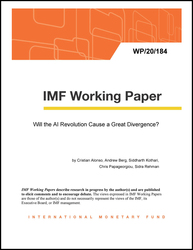
Will the AI Revolution Cause a Great Divergence?
Will the AI Revolution Cause a Great Divergence?
READ MORE...
Volume/Issue:
Volume 2020
Issue 184
Publication date: September 2020
ISBN: 9781513556505
$18.00
Add to Cart by clicking price of the language and format you'd like to purchase
Available Languages and Formats
| English |
Prices in red indicate formats that are not yet available but are forthcoming.
Topics covered in this book
This title contains information about the following subjects.
Click on a subject if you would like to see other titles with the same subjects.
Labor , Economics- Macroeconomics , WP , production function , financial asset , Automation , robots , divergence , development , technological change , advanced economy , labor share , unskilled labor , developing economy , robot productivity , robot share , Robotics , Unskilled labor , Labor share , Skilled labor , Global , parameter e , unskilled-labor-saving technology
Also of interest
Summary
This paper considers the implications for developing countries of a new wave of technological change that substitutes pervasively for labor. It makes simple and plausible assumptions: the AI revolution can be modeled as an increase in productivity of a distinct type of capital that substitutes closely with labor; and the only fundamental difference between the advanced and developing country is the level of TFP. This set-up is minimalist, but the resulting conclusions are powerful: improvements in the productivity of “robots” drive divergence, as advanced countries differentially benefit from their initially higher robot intensity, driven by their endogenously higher wages and stock of complementary traditional capital. In addition, capital—if internationally mobile—is pulled “uphill”, resulting in a transitional GDP decline in the developing country. In an extended model where robots substitute only for unskilled labor, the terms of trade, and hence GDP, may decline permanently for the country relatively well-endowed in unskilled labor.
Copyright © 2010 - 2025
Powered by:
AIDC



